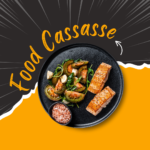Welcome to the enchanting realm of Cassasse, a dish as captivating as its name suggests! Whether you’re an avid culinary explorer or simply intrigued by new flavors, this article will guide you through the origins, ingredients, recipes, health benefits, cultural significance, and even offer tips for creating your own mouthwatering Cassasse at home. So, take a seat and prepare to immerse yourself in the delectable allure of Cassasse – let’s unravel everything about this extraordinary dish!
The Origin and History of Cassasse
The roots of Cassasse can be traced back to the culinary traditions of the Mediterranean and Middle Eastern cultures. While its exact origins are shrouded in mystery, Cassasse has been enjoyed for centuries across various countries.
With a fascinating history, different regions have infused their unique twists into the recipe. Some consider Cassasse a comforting family heirloom, passed down through generations, while others reserve it for special celebrations or festivals.
Deeply entwined in culture and tradition, Cassasse has evolved over time without losing its essence and popularity. Its versatility makes it suitable for everyday meals and festive gatherings alike.
As this mouthwatering dish continues to captivate taste buds worldwide, chefs and home cooks have adapted traditional recipes, introducing exciting flavors and showcasing culinary creativity and innovation.
Ingredients Used in Making Cassasse
Cassasse, a delightful dish enjoyed globally, incorporates a unique blend of ingredients that define its distinct taste and texture. While variations exist, the fundamental components remain consistent.
- Flour: Serving as the base for the dough, flour provides structure and elasticity, with options like all-purpose or bread flour.
- Yeast: This magical microorganism leavens the dough, making it light and airy, contributing to its texture.
- Spices: Common spices such as salt, sugar, and sometimes herbs like rosemary or thyme add flavor and complexity.
- Water: Crucial for bringing all ingredients together, creating the necessary hydration for gluten development.
- Olive Oil: Known for its rich flavor, and eggs contributing richness and moisture to the dish.
Combining these essential ingredients with care results in a mouthwatering delicacy cherished by people from diverse backgrounds.
Traditional vs. Modern Cassasse Recipes
Traditional Cassasse recipes, passed down through generations, preserve authenticity and cultural significance, often involving staple ingredients like flour, sugar, eggs, and butter. Traditional methods may require hand mixing or kneading.
Modern Cassasse recipes offer a contemporary twist, incorporating innovative ingredients like chocolate chips, nuts, or fruits, and leveraging kitchen gadgets for convenience. Whether traditional or modern, both versions offer delightful treats with unique characteristics, appealing to personal preferences.
Choosing between tradition and innovation depends on individual tastes. Traditionalists may appreciate the nostalgia of family recipes, while those embracing culinary experimentation find joy in modern adaptations. Regardless, indulging in homemade Cassasse is always a delightful experience.
Health Benefits of Consuming Cassasse
Cassasse, made with wholesome ingredients and traditional methods, offers not only deliciousness but also nutritional benefits. Key ingredients like fish provide lean protein, essential for tissue repair and muscle growth. Vegetables in Cassasse offer vitamins, minerals, and antioxidants for overall health.
Cassava flour, a gluten-free option, adds fiber for digestion and contains essential nutrients like vitamin C and potassium. The slow, gentle cooking process preserves nutritional value, making Cassasse a nutritious addition to the diet.
Cultural Significance of Cassasse in Different Countries
Cassasse holds a special place in culinary traditions globally, with each country infusing its unique flair into this delightful dish.
- In Italy, known as “cassata,” it’s a traditional dessert served during celebrations.
- In France, “cassoulet” is a savory casserole enjoyed in warm gatherings.
- In Brazil, “caçarola de frango” is a comforting chicken casserole representing Brazilian cuisine’s heartiness.
- In Morocco, “bastilla” is an exquisite pastry symbolizing hospitality during festivals like Ramadan.
From sweet to savory variations, Cassasse brings people together through shared experiences, celebrating love and community bonding.
How to Make Cassasse at Home
Embarking on the journey to make Cassasse at home allows you to savor its flavors in your kitchen. Here’s a simple guide:
- Gather Ingredients: Fresh seafood, aromatic vegetables, essential spices, and tomato sauce are key.
- Sauté Vegetables: Sauté onions, garlic, and bell peppers until tender, then add seafood until cooked.
- Add Tomato Sauce: Pour in tomato sauce, and enhance with Worcestershire sauce or hot sauce.
- Simmer: Let it simmer on low heat for around 20 minutes to meld flavors.
While it may require time and effort, the result is a rich and flavorful dish that transports you to the origins of Cassasse. Get creative by experimenting with different seafood, herbs, and spices to make it uniquely yours.
Tips for Pairing Cassasse with Other Dishes
Cassasse’s unique flavors can be complemented by pairing it with various dishes:
- Fresh Greens: Balance the savory flavors with a crisp green salad or steamed vegetables.
- Grilled Meats: Pair with grilled chicken, beef, or lamb for a smoky and hearty combination.
- Seafood Pairings: Explore pairing with grilled shrimp or pan-seared scallops for a delightful contrast.
- Cheese Experimentation: Add grated Parmesan for a crispy crust or serve with creamy goat cheese for indulgence.
- Ethnic Fusions: Experiment with elements from different cuisines for creative fusion dishes.
By considering these tips, you can elevate the dining experience and explore the versatility of this delectable dish.
Conclusion
Cassasse, more than just a recipe, is a piece of history infused with culture and flavor. Whether embracing tradition or experimenting with modern twists, this culinary marvel has captured hearts worldwide. Beyond its tantalizing taste, Cassasse offers health benefits and holds cultural significance, symbolizing unity and shared joy.
For those inspired to try making Cassasse at home, it’s an opportunity to bring tradition to your kitchen and impress with culinary skills. Experiment with flavors, pairings, and make it uniquely yours.
For more information click here.
In conclusion, Cassasse is a gastronomic journey that transcends mere culinary exploration – it’s an experience, a tradition, and a celebration of flavors that unites people across cultures and generations. So, why not embark on this delightful adventure? Discover the magic behind each bite and embrace the traditions that have made Cassasse a beloved dish worldwide.


